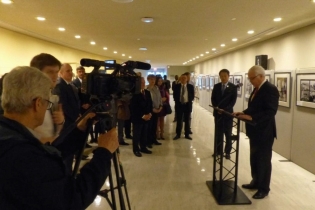Statement by Ambassador Vitaly I. Churkin, Permanent Representative of the Russian Federation to the United Nations, at an opening of the exhibition dedicated to the 55th Anniversary of the First Human Space Flight
April 12th, 2016Dear colleagues,
Ladies and Gentlemen,
Five years ago the UN General Assembly recalled “that 12 April 1961 was the date of the first human space flight, carried out by Yuri Gagarin, a Soviet citizen born in Russia, acknowledged that this historic event opened the way for space exploration for the benefit of all mankind” and declared “April 12 as the International Day of Human Space Flight to celebrate each year at the international level the beginning of the space era for Humankind, reaffirming the important contribution of space science and technology in achieving sustainable development goals and increasing the well-being of States and peoples, as well as ensuring the realization of their aspiration to maintain outer space for peaceful purposes”.
Space flights, obviously, are not there only to fuel that great engine of scientific progress – human curiosity. They have increasingly important practical implications – in meteorology, agriculture, climate, pollution control, life on land and in the oceans – all those fields where the United Nations and the international community are involved to achieve goals of sustainable development. People of different nationalities and religions work in Space conquest programs together in peace, cooperation and harmony.
Today we celebrate the 55th Anniversary of Yuri Gagarin’s historic flight.
Based on the sketches of Russian scientist Konstantin Tsiolkovsky in the beginning of the 20th century, the dream became a reality thanks to the talent and efforts of thousands of people – scientists, constructors, engineers, workers and military specialists, headed by Chief designer Sergey Korolev. That fact was particularly remarkable since it came only 16 years after World War II brought unspeakable devastation to our country.
Inevitable competition followed. In 1969 the Americans set foot on the Moon. But then as the cold war was beginning to thaw the world could see Russian cosmonauts and American astronauts working together – in the 1975 Apollo-Soyuz docking – as a powerful symbol of space being a venue for cooperation rather than confrontation.
Our country is understandably proud of our space achievements. First woman cosmonaut Valentina Tereshkova, first space walk by Aleksey Leonov, the longest continuing space flight of 438 days by Valery Poliakov. Overall 120 men and women from our country made it into space (of 555 humans from 14 countries that have seen our planet from space by now).
Even as we speak the International Space Station with 3 Russians, 2 Americans and 1 Englishman is continuing to make its laps around the Earth - staying orbit for 6354 days.
Ladies and Gentlemen,
The exhibition that we’ve prepared for you consists of materials provided by the Russian Federal Space Agency and the TASS Information Agency. We have here a couple of photos showing Yuri Gagarin’s and Valentina Tereshkova’s visit to the United Nations in 1963.
And after this brief ceremony I invite you to Conference Room One situated one floor down to watch a 2013 movie “Gagarin. First in space” that tells the story of the race for the first space flight.
Ladies and Gentlemen,
To ensure favorable conditions for continuing Universe exploration for the benefit of Humanity we must ensure that outer Space stays free of any weapons. That’s what the well-known joint Russian-Chinese initiative and subsequent UN General Assembly resolution “No first placement of weapons in outer Space” aims at. And it’s symbolic that Under Secretary-Genera
Mr.Kim Won-soo, I invite you to say a few words.
